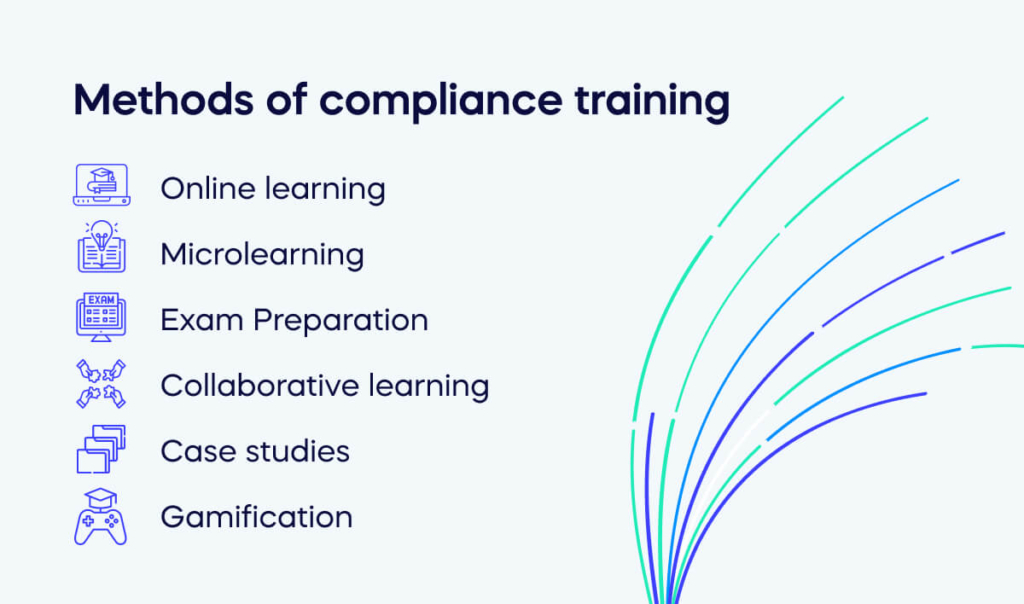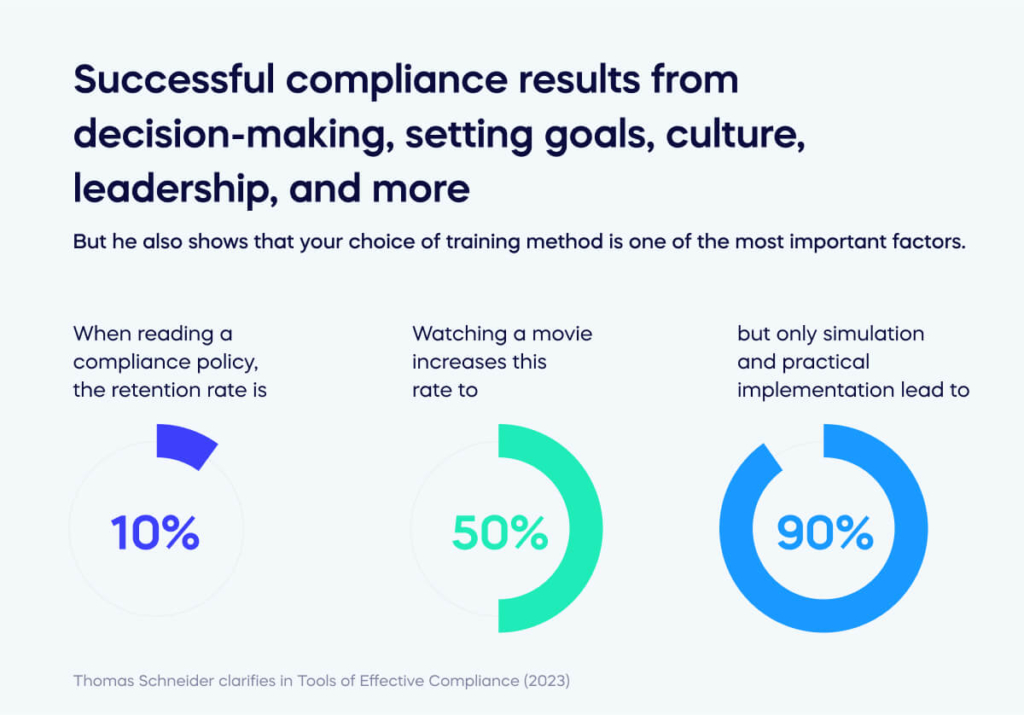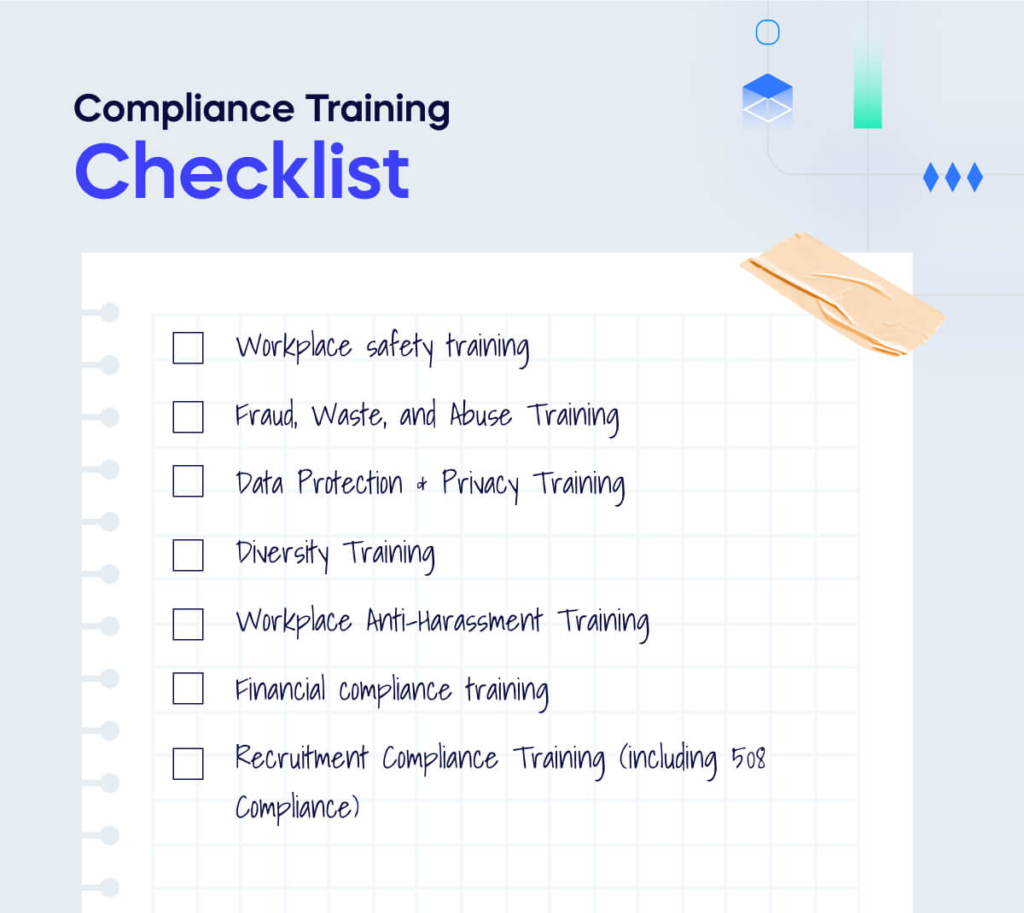Would you want to eat in a restaurant that had failed a hygiene inspection? Probably not. That’s because you know that hygiene regulations make kitchens safe. When a restaurant prides itself in compliance, customers can rest assured that they are getting the quality service and products they need.
For business owners, legal compliance feels like yet another burden. But for consumers, it offers them peace of mind.
Food hygiene is, of course, just the simplest example. Compliance regulations govern various business behaviors – from employee rights to advertising to financial transactions. Organizations are starting to expand their global compliance programs in an effort to maintain their reputation, protect the consumer and, ultimately, create a more secure global business environment.
Good training is an important step to secure compliance. Bad training is not enough when you have complex unit-specific and organization-wide protocols. Box-ticking and form-signing will only take you so far. A key HBR article explains that paper trails can make a “pro forma” exercise, which staff signs without changing their behavior.
This article will give you the low-down on compliance training. We’ll discuss how to deliver it, who is responsible for it, and who monitors it. We’ll explain why it’s important and show you the types of compliance training you may need. Finally, we’ll consider how you can evaluate training.
What is Compliance Training?
In a business context, compliance is an organization’s responsibility to behave within all relevant laws, regulations, and industry standards that apply to its operations. Compliance can cover many areas, including financial regulations, data privacy and security, environmental regulations, health and safety regulations, and labor laws. Compliance standards also cover internal company policies.
Compliance training programs are one of the most effective strategies for achieving compliance. The industry constantly changes, and you cannot assume all staff members have up-to-date knowledge. If your staff fully understands key industry policies, you have a much higher chance of fulfilling your regulatory obligations.
In this section, we’ll think about three aspects of compliance training: training methods, the importance of training programs, and how compliance is monitored.
Methods of compliance training

Choosing a training method is very important.
As Thomas Schneider clarifies in Tools of Effective Compliance (2023), successful compliance results from decision-making, setting goals, culture, leadership, and more. But he also shows that your choice of training method is one of the most important factors.

He explains, “When reading a compliance policy, the retention rate is 10%. Watching a movie increases this rate to 50%, but only simulation and practical implementation lead to 90%.”
Many compliance training methods you can use are similar to other types of employee training. That might include:
- Online learning
- Microlearning
- Exam Preparation
- Collaborative learning
- Case studies
- Gamification
There are many employee training methods out there. Consider your options and choose wisely.
Who is Responsible for Compliance Training?
Compliance doesn’t rely on people’s goodwill. It requires scrutiny, monitoring, and regulation from many different parties. Many different parties may investigate your compliance training outcomes.
- At a grass-roots level, internal whistle-blowers can draw public attention to poor practices. Since many countries have legal protection for whistle-blowers, some companies make it easy for employees to call out problems.
- The burden of legal responsibility is typically on the employer, not the employee. That’s why documentation, training, and leadership are important for successful compliance.
- Then, there are professional bodies, such as the American Bar Association, the International Organization for Standardization, and the Association of Chartered Certified Accountants. This might have regular inspections, public hearings (in the case of misconduct), and authority to shut down operations.
- At the top, professional bodies get their powers from government departments and agencies.
Many people will be interested in your compliance training protocols and their outcomes. Don’t take a risk – as the consequences can be severe.
The Consequences of Inadequate Compliance Training
With poor training, staff at every level of the organization can break federal or industry compliance regulations.
Individual employees and companies could face legal action for:
- financial reasons (taking on too much debt, misstating income)
- employee conditions (not meeting minimum wage, not providing adequate breaks)
- environmental health (Flint water crisis)
The results of failing compliance checks can be severe. Outcomes could include:
- Suspending or removing a professional license
- Setting targets for re-opening
- Imposing fines
The consequences of bad training might not become clear until it’s too late. The easiest way of dealing with the consequences is to avoid them in the first place.
The Importance of Compliance Training
As we’ve seen, compliance training is an easy way to avoid the negative consequences. You won’t have to pay fines, lawsuits, and other penalties if you spend money on good compliance training.
But there is more to it. You will see more benefits when you engage with compliance training seriously and enthusiastically.
- It ensures that you are behaving ethically.
- But also, internal compliance improves business processes.
- Finally, it helps improve customer trust in your operations.
Collectively, these reasons strongly motivate upholding the best compliance training in your organization.
Compliance Training Checklist

Even with the best will in the world, compliance across a complex organization is difficult. Leadership teams have to pay attention to many things that are going on.
This section gives you a checklist of the compliance training programs you may need to run in your organization. Take a look through and see what you need.
Workplace safety training
Workplace safety training helps employees identify and manage risks in the workplace. Safety training gives staff the knowledge to prevent accidents and injuries. Compliance is only one of the benefits of safety training. It also helps reduce workplace injuries and illnesses and thereby improve employee morale.
Fraud, Waste, and Abuse Training
Fraud, Waste, and Abuse (FWA) training prevents the misuse of company funds. FWA training typically covers topics such as how to identify fraudulent activities, how to report suspected fraud, and how to comply with relevant laws and regulations. Effective FWA training can help organizations comply with applicable laws and regulations, reduce the risk of financial loss, and maintain the trust of customers and stakeholders.
Data Protection & Privacy Training
Data protection is a key area for tech-heavy companies that deal with sensitive information. Data leaders must work hard to stay current on the latest legal developments. So regular training programs must keep all staff up to date.
This type of training is especially important for employees who handle personal or sensitive information, such as customer data or financial records. The training covers topics such as data security, privacy laws and regulations, and best practices for handling and storing sensitive information.
Diversity Training
Today’s corporations are under close scrutiny regarding diversity, inclusion, and anti-racism.
It’s now vitally important for every company to take a proactive approach to prevent discrimination. Specific topics can include recruitment practices, unconscious bias, and cross-cultural communication.
Workplace Anti-Harassment Training
Workplace anti-harassment training gives employees the tools to prevent inappropriate workplace behavior. The training covers topics such as the definition of harassment, the types of behavior that can constitute harassment, the legal implications of harassment, and the responsibilities of employees and managers in preventing and addressing harassment. Workplace anti-harassment training aims to create a safe and respectful workplace culture where all employees feel valued and supported.
Financial compliance training
Financial compliance training is designed to help employees understand the laws and regulations that govern financial transactions in their organization. This training covers anti-money laundering (AML), anti-bribery and corruption, fraud prevention, and data protection. It provides guidance on identifying, reporting, and preventing financial crimes and how to comply with regulatory requirements. The training may also cover the organization’s internal policies and procedures related to financial transactions, such as expense reporting, budgeting, and invoicing.
Recruitment Compliance Training (including 508 Compliance)
Recruitment compliance training, including 508 compliance, is designed to help organizations comply with legal and regulatory requirements related to recruitment and hiring. The training covers discrimination, equal opportunity, accessibility, and affirmative action. It provides guidance on developing compliant job descriptions, conducting fair and inclusive interviews, and making hiring decisions based on merit and qualifications.
508 compliance training specifically focuses on ensuring that the recruitment process is accessible to people with disabilities, including making job postings and applications accessible, as well as accommodating candidates with disabilities during the recruitment process
Measuring Compliance Training
Measuring compliance training is a key part of its success.
Imagine you’re the leader in charge of compliance. If anyone asks about regulation, perhaps the C-suite can point to big ring binders full of policies. They boast about all the training programs staff has finished. And can pull out signed documents from employees to say they understand the current policies.
Unfortunately, none of these measures are enough. So it’s no surprise that failure to evaluate is one of the most common problems with compliance training.
To be fair, evaluating training is never easy. And the KPIs for compliance training may be even more difficult than usual. For example, the US DHHS compiled a list of over 500 compliance training metrics.
So, make sure you choose metrics that connect with the key outcomes. Do you want a change in behavior, better knowledge, or something else?
If you’re still relying on signatures and “finishing”, get ready for a compliance failure.
How to Automate Compliance Training
As a 2021 IBE survey showed, most companies understand the importance of training. That’s great news for businesses, customers, and employees alike. As we’ve seen in this article, there are many reasons that compliance training is useful. And it’s good to know that many companies are trying to find the benefits.
The future of compliance training is bright. AI models mean that the cost of training will reduce, and its effectiveness will increase. As a 2022 Gartner press release explains, “Embedded controls are built-in, process-based mechanisms that shepherd employees to compliance within their workflows and maybe detective, preventive, or corrective.”
This guide has shown you the importance of compliance training. We’ve been through its meaning, importance, and implications. Then, we shared some key forms of compliance training you need to check-in.
Now, all you need to do is keep yourself educated about the latest innovations. Automated compliance training is coming – so don’t get left behind!


